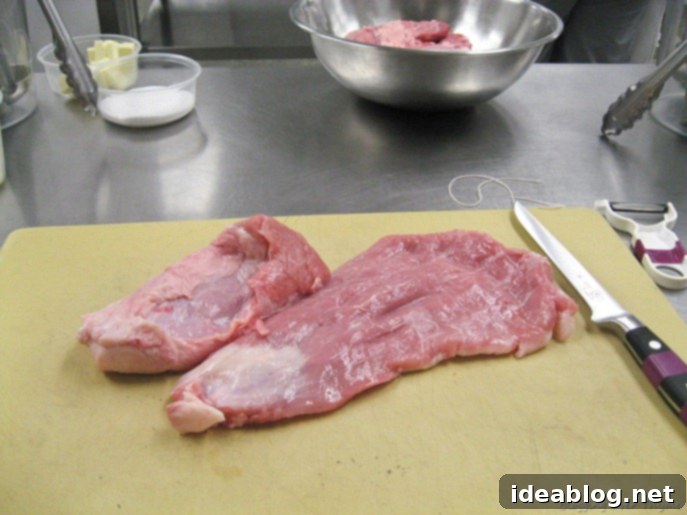Mastering Classic French Cuisine: Week Four’s Culinary School Odyssey of Tarts, Blanquettes, and Soups
Week four, day one, marked yet another significant milestone in our culinary journey. Each day spent in the professional kitchen leaves me astonished by the sheer volume of skills and dishes we master, even if service occasionally feels like a controlled flurry of activity. Today’s curriculum introduced an exciting array of new dishes and refined techniques, pushing our abilities further. We were particularly thrilled to welcome Chef Somchet, a new pastry instructor from Thailand, who made her debut today. Her vibrant personality and extensive knowledge immediately brightened the kitchen. Chef Somchet will be guiding us through the intricate world of pastries and desserts from now on, with the promise of incorporating some delightful Asian dishes whenever time permits.
Our first delightful creation under her tutelage was the exquisite LA TARTE AUX POISES BOURDALOUE, famously known as the poached pear tart. This classic French dessert combines elegant flavors and textures into a truly satisfying experience.
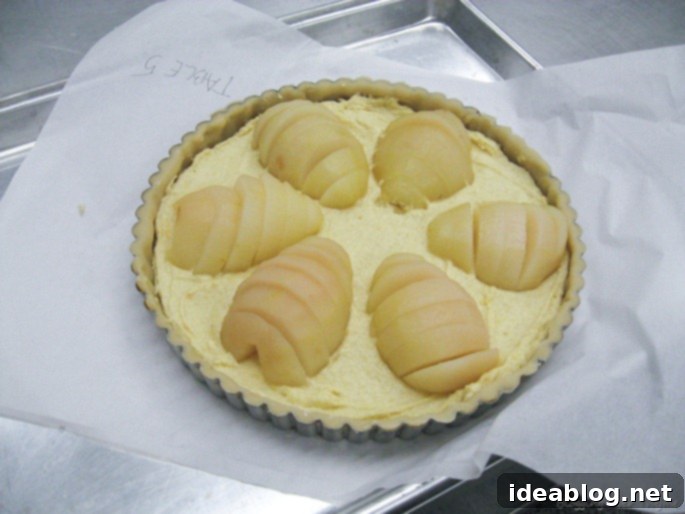
Crafting the Perfect Poached Pear Tart
This beautiful tart showcases a meticulously prepared pâte sucrée tart shell, a rich frangipane filling, and tender pears delicately poached in a vanilla bean-infused simple syrup. The pâte sucrée, a sweet shortcrust pastry, provides a sturdy yet crumbly base that perfectly complements the soft filling. Unlike some tart preparations, our shell was not blind-baked beforehand, as the frangipane requires substantial baking time to cook through properly, eliminating the need for a preliminary bake.
The heart of this tart lies in its luxurious frangipane filling. This almond cream is a delightful concoction, meticulously blended using our stand mixers. Its key components include softened butter, granulated sugar, fine almond flour, whole eggs, a hint of vanilla extract, bright lemon zest, a touch of rum for added depth, and a minimal amount of all-purpose flour to give it structure. Each ingredient plays a crucial role, from the almond flour providing its characteristic nutty flavor and texture, to the rum enhancing the overall aroma and taste profile.
While the frangipane came together, we simultaneously prepared our pears. This involved carefully peeling them and immediately rubbing them with lemon juice to prevent any unsightly oxidation, preserving their pristine appearance. After coring, the pears were gently poached in a simple syrup, subtly flavored with half a vanilla bean. The poaching process was maintained at a bare simmer, ensuring the pears softened evenly without losing their form. Once they reached a delightful fork-tender stage, they were promptly removed from the hot syrup and placed into a bowl nestled over an ice bath to cool quickly. This rapid cooling halts the cooking process and maintains their firm texture. Subsequently, the cooled pears were sliced with precision, ready for assembly.
Assembling the tart was a delicate art. We first filled the pâte sucrée shell halfway with the fragrant frangipane, spreading it evenly with an offset spatula. Then, the elegantly sliced poached pears were arranged in a beautiful circular pattern on top of the frangipane. The tart then ventured into the oven, baking for approximately 45 minutes, during which the frangipane filling wonderfully expanded and turned golden brown. The final touch, once baked, was a generous brushing of warm apricot glaze, imparting a brilliant shine and a subtle fruity sweetness that tied all the flavors together. The result was not just delicious but also visually stunning—a true testament to classic French patisserie.
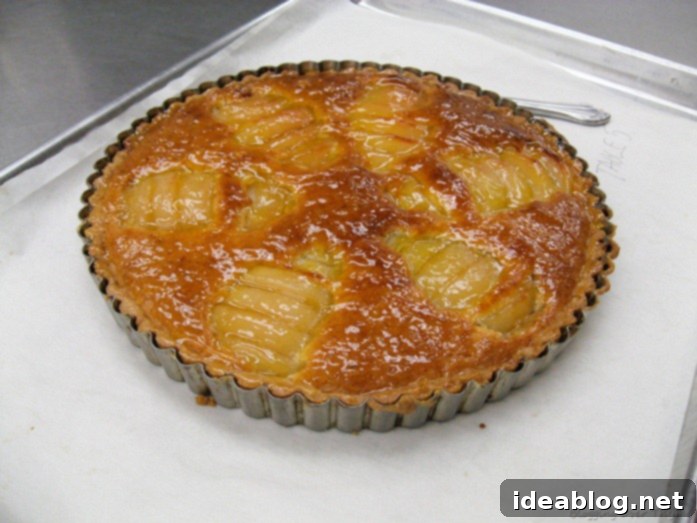
The Savory Star: Classic Veal Blanquette
Transitioning from sweet to savory, our main dish of the day was the venerable LA BLANQUETTE DE VEAU À L’ANCIENNE AUX CHAMPIGNONS—a traditional French veal blanquette served with pearl onions and mushrooms. This dish marked an exciting progression in our protein repertoire; having focused on chicken and fish last week, we were now diving into the rich world of veal. For many of us, including myself, this was our very first experience cooking veal, a truly momentous occasion in our culinary training.
A blanquette is, at its essence, a French stew characterized by its creamy, white sauce—the name “blanquette” itself derives from “blanc,” meaning white. Unlike many stews that feature browned meat, a blanquette emphasizes a pale, delicate presentation. Today, we utilized veal neck, a cut celebrated for its robust flavor despite being one of the tougher parts of the animal. Its fibrous nature necessitates a long, slow cooking process to break down connective tissues and render it incredibly tender. This low-and-slow approach is critical to prevent the protein from shrinking excessively and losing its precious fat and moisture, which would otherwise result in tough, dry meat. Our preparation began with meticulously trimming all excess fat and the somewhat unfortunately named “silver skin” from the veal neck. Following this, the meat was cut against the grain into uniform, small chunks, optimizing tenderness.
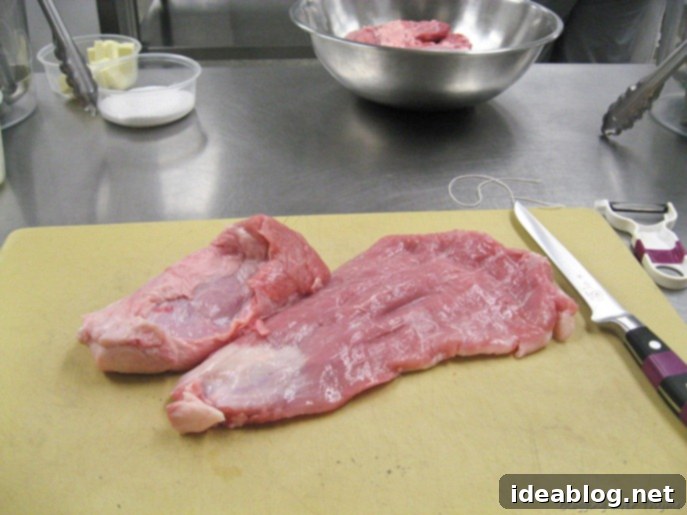
The cooking process for the veal blanquette starts unconventionally, yet intentionally. The trimmed veal pieces were covered with cold stock—a crucial step often overlooked. Using cold stock ensures that the veal gradually heats up, allowing any impurities and excess fat to slowly rise to the surface as foam, which can then be skimmed off. If warm stock were used, it would rapidly cook the exterior of the veal, locking in impurities and fat, making it difficult to achieve the desired clean, white sauce. The stock and veal were then slowly brought to heat, maintaining a temperature just below a simmer, never allowing a vigorous boil.
As the liquid gently heated, we carefully skimmed off any foam or fat that rose to the surface, clarifying the broth. Following this, we introduced our aromatics: an onion piqué and a bouquet garni. An onion piqué is half an onion studded with cloves, providing a subtle, sweet spice. The bouquet garni, a classic French aromatic bundle, consisted of fresh carrot, leek, celery, sprigs of thyme, a bay leaf, and parsley, all neatly tied together with string for easy removal. These aromatics infused the cooking liquid with a complex flavor profile as the veal slowly braised.
The veal was left to cook gently over low heat for at least one to two hours, or until it reached peak tenderness, practically melting in the mouth. Once achieved, the meat was carefully strained from the cooking liquid. The liquid, now rich with flavor, was reserved and passed through a chinois, a fine-mesh conical sieve, to ensure it was perfectly smooth and free of any impurities. The tender veal chunks were set aside while we proceeded to thicken the strained cooking liquid. This was achieved by incorporating a roux, a classic French thickening agent made from equal parts butter and flour, cooked on the stovetop to eliminate any raw flour taste. After whisking in the roux, a touch of heavy cream was added for richness, and then, a surprising yet traditional ingredient: an egg yolk. The egg yolk, carefully tempered to prevent scrambling, is one of the time-honored methods to thicken and emulsify a blanquette de veau, lending it a velvety texture and a beautiful sheen without making it heavy.
With the stew sauce perfectly assembled, the tender veal meat was returned to the pot. We then added beautifully cooked pearl onions—which, as any cook knows, are notoriously fiddly to peel but undeniably worth the effort for their sweet, delicate flavor—and expertly sautéed button mushrooms. A final touch was the addition of the cooked carrot from the bouquet garni, finely chopped, adding color and sweetness. This hearty and elegant blanquette was then served alongside a fluffy rice pilaf, making for a truly satisfying and authentic French meal.
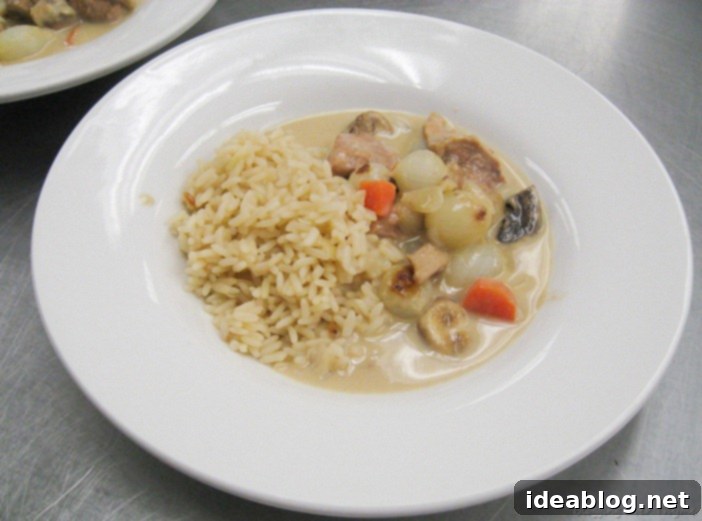
I confess, the idea of an egg yolk in a savory stew might sound peculiar to some—even I raised an eyebrow initially! However, I’m consistently proven wrong by these classic dishes. What often sounds unconventional on paper transforms into something truly delicious upon tasting. It’s a recurring theme in culinary school; I often approach a dish thinking it won’t be to my liking, only to discover its incredible depth and flavor. I suppose that’s precisely why these recipes have endured as cherished classics in French cuisine!
A Day of Hearty Soups: Le Potage Saint Germain
Indeed, this was officially dubbed the “day of soups and stews,” as in addition to our exquisite Blanquette de Veau, we also crafted a delightful LE POTAGE SAINT GERMAIN, a classic French pea soup. The designation ‘Saint Germain’ is significant, indicating that the soup is specifically made with peas and is named after the Saint-Germain-en-Laye region in France, where this comforting dish is believed to have originated.
Ultimately, this soup proved to be surprisingly simple to prepare and remarkably delicious—even for someone like me who isn’t usually a fervent admirer of peas! We began by gently sweating finely diced leeks and celery until translucent, forming a flavorful aromatic base. To this, we added good quality stock and, eventually, frozen peas. While fresh peas are ideal when in season, high-quality frozen peas offer a convenient and equally flavorful alternative, especially in a professional kitchen setting where consistency is key. For additional depth of flavor and aromatics, we incorporated a substantial piece of bacon, garlic, fresh thyme, parsley, and a bay leaf. The bacon, perhaps not surprisingly, imparted a wonderful smoky richness that elevated the humble pea.
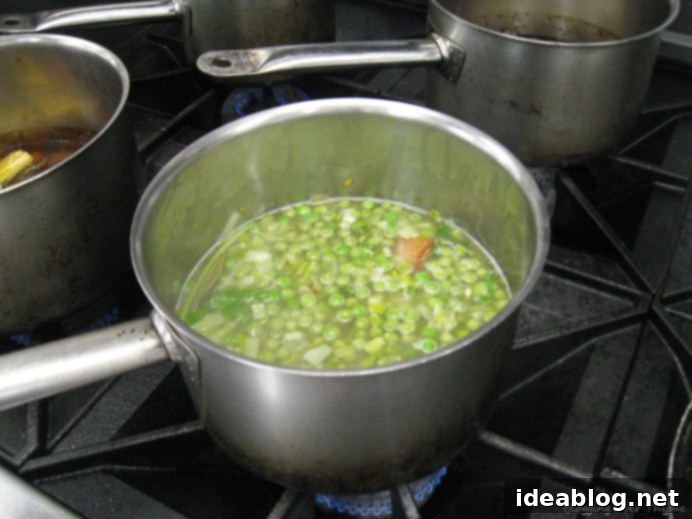
Once the mixture had simmered gently for a while, allowing all the flavors to meld beautifully, we transferred it to a blender. It was then pureed until perfectly smooth and subsequently passed through a chinois. This extra step of straining through the fine mesh sieve is crucial for achieving the characteristic velvety texture that defines a classic Potage Saint Germain, making it exceptionally refined and thin. Just before service, a pat of cold butter was whisked into the hot soup—a technique known as ‘monte au beurre.’ This not only enriches the soup but also adds a desirable glossy sheen, enhancing its visual appeal and making it even more delectable.
For garnish, we prepared crisp croutons, made simply by sautéing small bread cubes in butter until golden brown. We also diced and crisped up the very bacon used to flavor the soup, providing a savory, textural contrast. This final presentation transformed a simple pea soup into an elegant and satisfying starter.
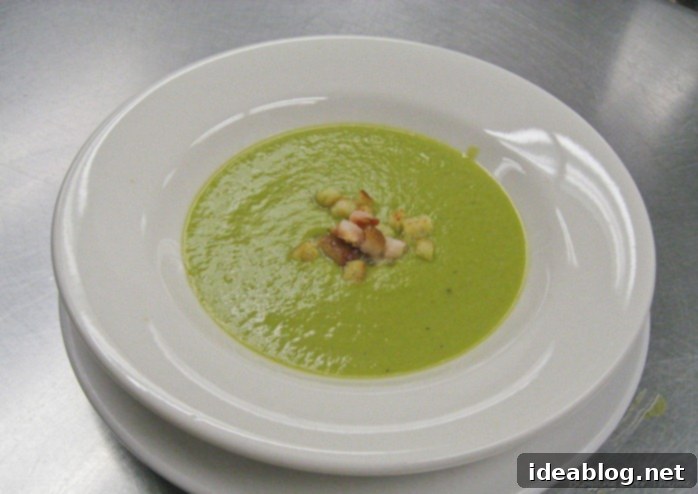
Reflections on a Productive Culinary Day
What a perfectly curated menu for a chilly winter day! I am immensely grateful that I embarked on this culinary program in January, as it means I can truly savor and appreciate all these comforting soups and hearty stews we are learning to master. I can hardly imagine enjoying such rich, warming lunches in the oppressive heat of summer!
Overall, today felt remarkably calm and controlled, especially when contrasted with our incredibly demanding menu on Friday. While the end-of-service rush to plate and serve everything remains a constant, there was a palpable sense that we largely had things under control throughout the day. This feeling of competence and smooth execution is always a welcome relief and a sign of our growing proficiency in the kitchen.
Now, my focus shifts to preparing for my very first practical and theory exam, which looms this Thursday! In addition to this significant hurdle, our comprehensive recipe notebooks are also due soon. I haven’t even had a chance to tell you all about the meticulous process of compiling them, but rest assured, they are quite the undertaking. Woops!
Happy Monday to all, and wish me luck!
